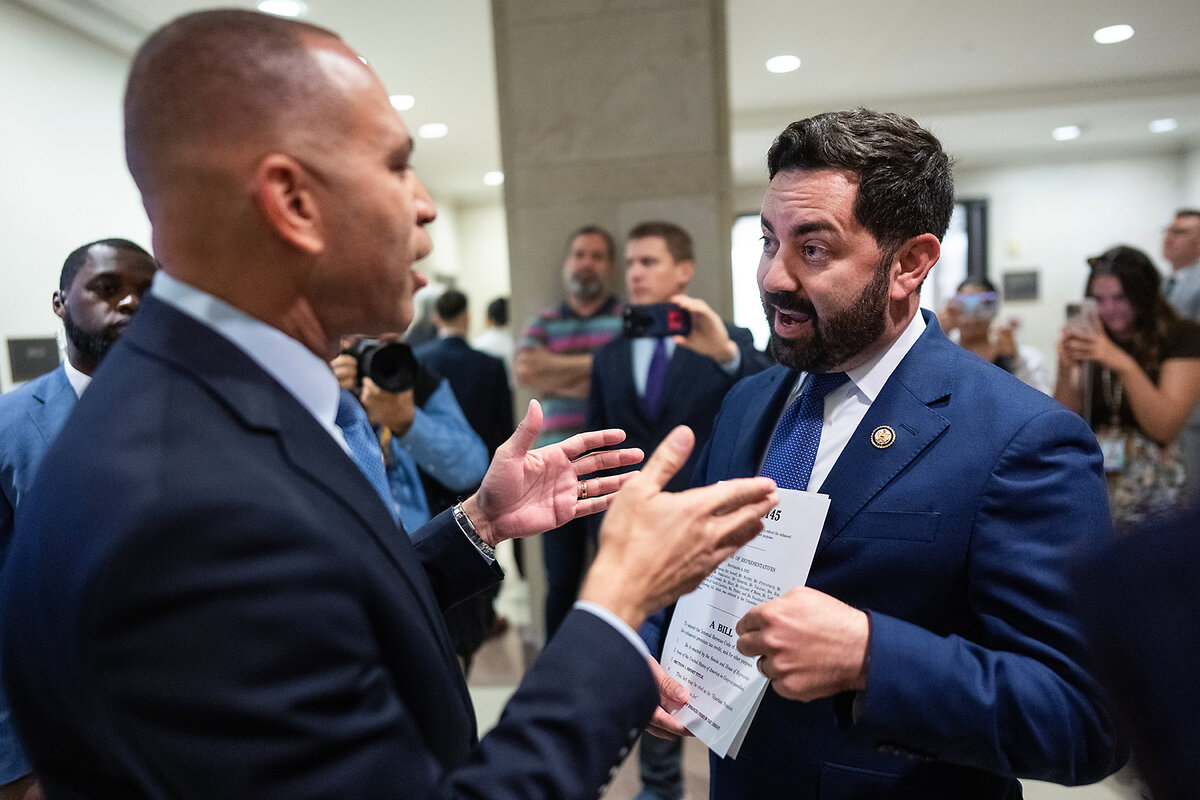

At the heart of what is now the longest U.S. government shutdown in history are federal subsidies that millions of Americans use to purchase health insurance on government-run marketplaces.
The shutdown began as Democrats dug in their heels to prevent these subsidies from expiring. And now, members of Congress are facing increasing pressure to end the shutdown – not just because of its effects on airports and federal programs like nutrition assistance, but also because of public concerns about rising insurance premiums.
These subsidies were greatly expanded in 2021 by Democrats who controlled Congress at the time. This led to a surge in enrollment on these marketplaces, which were created in 2010 under the Affordable Care Act (ACA), also known as Obamacare.
The expanded subsidies are set to expire next month, driving up premiums for many individuals and families who buy health insurance on Obamacare exchanges. For weeks, Democrats have called on Republicans to agree to extend the subsidies as a condition of reopening the government. Republicans have criticized the subsidies as wasteful and open to abuse, while arguing that the government must reopen first before Congress can discuss health insurance.
Open enrollment in marketplaces for 2026 plans began Nov. 1. Published prices show a large increase in the cost of many plans, reflecting uncertainty over what will happen to the expanded subsidies. The majority of enrollees receive some level of support designed to make Obamacare more affordable and increase the insured pool. The overall cost of insurance has been rising, in large part because U.S. health care is far more expensive than in peer countries.
Dawn Schmidt doesn’t know yet how much her premiums will rise next year, but she’s worried about being able to afford her insurance plan. She retired from her job at Boeing in 2020 and lives in Pennsylvania, which administers its own ACA marketplace, known as Pennie. Administrators have warned her that premiums could rise by 82%. “It’s a lot. It adds up,” she says.
What are the expanded subsidies, and why are they expiring?
Subsidies were baked into Obamacare from the start. The idea was to assist individuals who didn’t have either employee-provided plans or access to Medicaid or Medicare, but couldn’t afford the market price of private insurance. Those with low incomes were required to pay between 2% and 10% of their income, with the government paying the rest.
The expanded subsidies were introduced by Democrats in 2021 during the COVID-19 pandemic, when access to health care was a pressing concern. Financial support was extended to Americans making more than four times the federal poverty level, now above $60,000 for an individual enrollee, while those with the lowest incomes no longer had to pay any premiums. Enrollment more than doubled, from around 12 million in 2021 to 24 million in 2024.
“We have more people in the system than we’ve ever had before, and that’s a good thing,” says Elena Marks, a health policy expert at Rice University’s Baker Institute for Public Policy. But, she adds, “the underlying costs continue to escalate … which is a bad thing.”
To pass the legislation, Democrats had to set an expiration date to satisfy congressional fiscal rules. This created an enrollment cliff that was already causing concern before the impasse on government spending that led to the Oct. 1 shutdown.
How are Democrats and Republicans responding?
Democrats have tried to use the enrollment cliff as leverage to force an extension. Citing higher premiums in New York, Sen. Chuck Schumer has accused Republicans of ignoring a “healthcare crisis” that could see millions lose coverage if subsidies are slashed. “These devastating price hikes are entirely avoidable, but if Republicans keep stick[ing] their heads in the sand, New York families will be paying the price,” he said in a statement.
Most Republicans take a different view. They point to the fiscal burden of extending subsidies that, if made permanent, would cost around $350 billion over 10 years, according to estimates from the Congressional Budget Office. They question the design of Obamacare and its failure to curb rising health care costs, as well as the risk of waste and fraud. Some want to scrap the Affordable Care Act and replace it with an alternative approach.
But a redo of Obamacare is politically fraught. A GOP-led effort to repeal it in 2017 failed to pass the Senate amid infighting over what exactly would replace it. Some Republicans would prefer to extend the expiring subsidies and work on reforms to the marketplaces, given that open enrollment for 2026 is already underway. Rep. Mike Lawler, a Republican who represents a swing district in New York, has co-sponsored a bipartisan bill to extend the credits for one year.
Polls suggest that the expanded subsidies are popular and that cutting them could sour voters on Republicans. A poll taken in September by KFF Health, a nonprofit research group, found that 3 in 4 respondents want the subsidies extended. In July, Tony Fabrizio, a pollster who has worked on campaigns for President Donald Trump, warned that “solid majorities of Trump voters and Swing voters” supported the subsidies and that their expiration could penalize Republicans in competitive districts in the 2026 midterms. GOP-run states such as Georgia and Florida have seen some of the biggest increases in Obamacare enrollment in recent years.
What are the possible consequences of cutting subsidies for Obamacare?
Higher premiums could deter millions of Americans from enrolling in the 2026 program, which means more uninsured people. Those with middle incomes who didn’t benefit from the original subsidy program may decide to pay more out of pocket. Experts say far greater attrition is likely among low-income groups whose costs were almost entirely subsidized.
While critics have questioned why taxpayers are supporting middle-aged couples who took early retirement, such individuals are in the minority. Only 7% of enrollees in marketplaces had incomes over four times the federal poverty rate and, as a result, were eligible for the expanded subsidies. Of these, around half were between the ages of 50 and 64.
Ms. Schmidt falls into this category: She retired early because her husband is older, and they wanted to make the most of their retirement. He is now on Medicare, while she is too young to qualify and buys Obamacare insurance. She paid $211 a month this year for her plan, which has a $6,000 deductible, and is bracing to pay more if subsidies are eliminated.
“We’re probably going to have to cut back on things like vacations. We already cut back on spending on our grandchildren for Christmas and birthdays,” she says.
The participation of early retirees in Obamacare was woven into its design, says Ms. Marks at Rice. “Part of the reason behind the ACA marketplace was to allow people to not stay in jobs they didn’t want to stay in, to get health insurance,” she says.
Still, they aren’t the main beneficiaries of federal aid, she adds. “Most of the subsidy dollars go to the lowest-income people.”
Even with subsidies, the rising cost of premiums puts a strain on pocketbooks. Young people are generally more likely to forgo health insurance and risk having to pay out of pocket for medical care. This creates a quandary for insurers and regulators, since young people tend to use less health care compared with older people; insurance pools rely on serving a demographic mix.
This has long been the challenge hanging over Obamacare: If not enough young people pay into the system and the resulting pool skews less healthy, eventually it no longer becomes viable for private insurers. The individual mandate to buy health insurance was supposed to tackle this problem. Congress deactivated it during Mr. Trump’s first term.
Behind this difficulty lies a stark reality: Americans pay far more for health care than other countries, and most of the provisions in Obamacare that were designed to curb rising costs have been rescinded or have stalled. Tens of millions are still uninsured. And, while policy experts have proposed various solutions, so far neither political party has been willing to significantly cut rising expenditures on health insurance programs for an aging population.
Why Obamacare and health costs take center stage amid shutdown
Sen. Mike Rounds told Politico he is pitching a one-year extension to fellow Republicans. GOP Sen. Lisa Murkowski proposed an extension in a framework for averting the shutdown. But so far, the two sides haven’t come together.
Across the country, people who have health insurance through the ACA marketplace are waiting to see how much they’ll pay in 2026. More than two-thirds of adults, in a February poll from the Pew Foundation, said health care affordability is a very big concern – second only to the role of money in politics.
Americans have seen decades of increases in health care costs. The nation’s health care spending for 2023 (totaling $4.9 trillion) was more than twice what it was in 2000 (amounting to $2.23 trillion), according to an analysis by Peterson-KFF, which adjusted the amounts for inflation. It was nearly 18% of the country’s gross domestic product in 2023.
Those rising costs are reflected in the use of the enhanced health care subsidies. Nearly $1 billion went toward households in California, for instance, that make more than four times the federal poverty level of just over $15,000 a year for a single person, or $31,000 for a family of four.
“People who are making six figures … that’s who we’re talking about giving subsidies to,” says Michael Cannon, director of health policy studies at the libertarian Cato Institute, which advocates for a free market solution to managing health care costs. “The government has made health care unaffordable for people making half a million per year,” he says, by injecting money into a system that desensitizes consumers to the costs of using it.
But those are also people who matter to politicians, says David Panush, president of the consulting firm California Health Policy Strategies. “To have an income of 400% poverty or more, they’re working, they’re voting, they’re paying attention.” He says voters “are going to be very angry” at lawmakers who allow premiums to soar.
How ACA premiums have surged
The Affordable Care Act passed in 2010 under President Barack Obama. It allowed more people to participate in Medicaid by raising income limits for the program, and overhauled the marketplace for private insurance with three primary components: It prevented insurance companies from turning people away for preexisting conditions, mandated that everyone participate, and provided subsidies to offset the costs for policyholders.
“If you’re going to require people to buy it, you have to make it affordable,” says Mr. Panush, who was on the team that launched Covered California. “Somebody has to pay for it, and that’s where the subsidies come in.”
In 2017, Congress passed President Donald Trump’s tax cut bill, which eliminated the insurance mandate. The new law also ended cost-sharing reduction payments for insurers, which had helped offset costs for lower-income policyholders.
The end of the mandate also affected one of the fundamental aspects of the Affordable Care Act, which was that if everyone participated in the insurance pool, the costs incurred by those who used more of the system were offset by those who used it less. If lower-risk policyholders opted out, the pool was left with higher-risk, more expensive participants.
The Biden administration increased subsidies in 2021 as part of the American Rescue Plan Act, providing more funding for existing enrollees and expanding the subsidies for middle-income families.
Since the 2021 enhancement, enrollment in ACA marketplace plans across the country has more than doubled.
“Those people came in because of the cost of health care,” says Jagdip Dhillon, a spokesperson for Covered California, where enrollment has gone up 23% since 2020.
But, conservatives say, the Biden-era subsidies are part of the problem with the Affordable Care Act.
“ObamaCare needs reform. Insurance plans are too expensive and unattractive for consumers,” Brian Blase, president of the conservative Paragon Health Institute, and Trevor Carlsen, a senior research fellow at the Foundation for Government Accountability, wrote in a September report. “Biden’s COVID credits give insurers even less incentive to design plans that people truly value because taxpayers cover nearly all of the costs. Pouring more taxpayer money into this broken system would only delay needed reforms.”
The example of Covered California
The enhanced tax credit provides about $2.5 billion for policyholders with Covered California.
Most of the nearly 2 million policyholders are self-employed, or small-business owners or early retirees. The subsidies support people who do not have access to traditional health care plans through employers, make too much to qualify for Medicaid, or do not meet age requirements for Medicare.
In California, if the enhanced subsidies end, as many as 400,000 people will be priced out of coverage, says Mr. Dhillon. And $190 million in state funding that went toward a deduction-free health plan this year will be reallocated to provide relief for the lowest-income individuals and families who qualify for ACA plans.
Experts say the exodus of policyholders will drive up premiums, because those who choose to keep the more expensive policies are likely to be people who use the system more. And the cost burden for those who have no insurance will also fall on public funds, says Mr. Dhillon.
Insurers in California are proposing rate increases from 7% to 20%. That range varies by company and state: Insurers in Arkansas have proposed the highest increases, up to 59%. In Florida, it’s 19% to 40%. Nebraska, 9% to 36%. One company in Pennsylvania has proposed a 10% decrease.
With the loss of the enhanced subsidies, and the increased rates, policyholders will on average pay more than double for their premiums, according to KFF. The Congressional Budget Office estimates more than 5 million people would be priced out of health insurance over the next decade.
You’ll have “millions nationally who are going to have to make some really agonizing choices,” says Mr. Panush.
No end in sight to shutdown
Lawmakers indicated no progress on resolving the standoff as of Thursday, when President Trump said he would be meeting with Office of Management and Budget Director Russell Vought to assess cuts to “Democrat Agencies.”

































:max_bytes(150000):strip_icc():focal(749x0:751x2)/joe-biden-cancer-bell-4-102125-755350df0d53433ca98388986729cb8f.jpg?w=1200&resize=1200,0&ssl=1)










